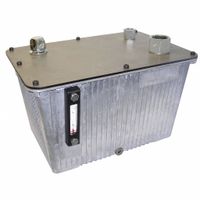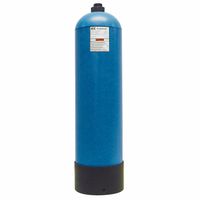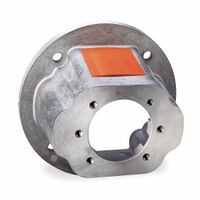Call +(254) 703 030 000 / 751 483 999 / 721 704 777
- Home
- Hydraulics
- Hydraulic Tanks
.....Read More
Frequently Asked Questions
What is the purpose of a hydraulic reservoir tank?
A hydraulic reservoir tank serves multiple crucial functions within a hydraulic system. Primarily, it acts as a storage container for hydraulic fluid, ensuring a sufficient supply is available to the pump and the rest of the system as needed. This allows for fluid expansion and contraction due to temperature changes, and accommodates volume changes as cylinders extend and retract. Beyond simple storage, the reservoir also plays a vital role in cooling the hydraulic fluid by dissipating heat into the surrounding atmosphere, which helps maintain optimal operating temperatures and prevents fluid degradation. Furthermore, it allows for the separation of air and contaminants from the fluid. Air bubbles can lead to cavitation and inefficient system operation, while contaminants can cause wear and damage to components. The design of a good reservoir often includes baffles to facilitate air release and settlement of particulate matter, and filters are typically integrated to further clean the fluid before it returns to the pump. In essence, the hydraulic reservoir is not just a tank; it's a critical component for maintaining fluid quality, managing temperature, and ensuring the long-term health and efficiency of the entire hydraulic system.
How do hydraulic tanks cool and filter fluid?
Hydraulic tanks perform crucial roles in cooling and filtering fluid within a hydraulic system. Cooling is achieved through several mechanisms, primarily heat dissipation from the tank's surface. Larger tanks with increased surface area allow for more efficient radiant and convective heat transfer to the surrounding air. Some tanks may also incorporate cooling fins or be designed with an external fan to enhance airflow and accelerate heat removal. The tank's design can also promote natural convection currents within the fluid, helping to distribute heat more evenly and bring hotter fluid into contact with the cooler tank walls.
Fluid filtration is another vital function. Hydraulic tanks typically house return line filters, which are positioned to clean the fluid as it returns from the system's actuators and components, preventing contaminants from re-entering the pump and other sensitive parts. These filters remove particulate matter, such as dirt, wear particles, and oxidation byproducts, protecting the system from damage and ensuring optimal performance. Additionally, some tanks may have suction strainers or filters to protect the pump from larger contaminants that might be present in the reservoir. Proper tank design, including baffles and proper inlet/outlet placement, also aids in allowing heavier contaminants to settle at the bottom of the tank, away from the pump's suction line, further contributing to fluid cleanliness. Regular maintenance, including filter replacement and tank cleaning, is essential to maintain the integrity of the hydraulic fluid and the overall system.
What materials are commonly used for hydraulic tanks?
Hydraulic tanks are typically constructed from materials that offer durability, corrosion resistance, and compatibility with hydraulic fluids. Common choices include: * Steel: Often used for its strength, durability, and cost-effectiveness. Steel tanks can be coated internally to prevent rust and chemical reactions with the hydraulic fluid.
* Aluminum: Chosen for its lighter weight and natural corrosion resistance, making it suitable for applications where weight is a concern.
* Stainless Steel: Provides excellent corrosion resistance, making it ideal for applications with corrosive environments or strict hygiene requirements. However, it is generally more expensive than regular steel.
* Plastics (e.g., polyethylene, polypropylene): Used for lighter-duty applications, smaller tanks, or where non-conductive properties are desired. They offer good corrosion resistance but may have lower pressure and temperature ratings than metal tanks.
How do hydraulic tank isolators work?
Hydraulic tank isolators, also known as bladder accumulators or diaphragm accumulators, work by separating a gas charge (typically nitrogen) from the hydraulic fluid within a system. This separation is achieved by a flexible barrier, such as a rubber bladder or diaphragm, inside a sealed shell. When the hydraulic system experiences pressure fluctuations or surges, the isolator absorbs these changes by compressing or expanding the gas charge.
In simpler terms, the isolator acts as a shock absorber for the hydraulic system. When pressure increases, the hydraulic fluid pushes against the bladder/diaphragm, compressing the gas and storing energy. When pressure drops, the compressed gas expands, pushing the fluid back into the system and maintaining a more stable pressure. This not only dampens pressure spikes and pulsations, protecting sensitive components, but also provides a reserve of hydraulic fluid for emergency situations or to compensate for minor leaks. By minimizing pressure variations, isolators improve system efficiency, extend component lifespan, and reduce noise and vibration.
What are the benefits of using aluminum tanks over steel tanks?
Aluminum tanks offer several advantages over steel tanks, particularly in applications where weight, corrosion resistance, and thermal conductivity are crucial.
Firstly, aluminum tanks are significantly lighter than their steel counterparts. This weight reduction can lead to improved fuel efficiency in vehicles, easier portability for portable gas cylinders (like those used in scuba diving or camping), and reduced structural stress in fixed installations.
Secondly, aluminum exhibits superior corrosion resistance compared to many types of steel, especially in the presence of water or certain chemicals. Aluminum naturally forms a passive oxide layer that protects it from further oxidation. While steel can be protected with coatings or galvanization, these can wear off or be damaged, leading to rust.
Thirdly, aluminum has better thermal conductivity than steel. This property can be beneficial in applications where rapid heat transfer is desired, such as in certain industrial processes or in cryogenic storage where maintaining low temperatures is important.
Additionally, aluminum is non-magnetic, which can be an advantage in certain specialized applications where magnetic interference needs to be avoided. Aluminum tanks are also often easier to recycle than steel tanks, contributing to environmental sustainability.
However, it's also important to note that steel tanks generally offer higher strength and can withstand higher pressures, making them more suitable for certain high-pressure industrial applications or situations where extreme durability is required. The choice between aluminum and steel tanks ultimately depends on the specific requirements of the application.
How do fluid level and temperature indicators function in hydraulic systems?
Fluid level and temperature indicators are crucial components in hydraulic systems, providing real-time data essential for optimal performance, preventive maintenance, and system safety.
Fluid level indicators, often sight gauges or electronic sensors, monitor the volume of hydraulic fluid in the reservoir. Sight gauges are simple visual tubes or windows on the tank, allowing operators to quickly assess the fluid level. Electronic sensors, conversely, offer more precise and automated monitoring. These can include float switches, which trigger an alarm when fluid levels drop below a set point, or continuous level sensors (e.g., ultrasonic or capacitive) that transmit a proportional signal to a control system. Maintaining the correct fluid level prevents cavitation, pump damage, and system inefficiencies by ensuring the pump always has an adequate supply of fluid.
Temperature indicators, such as bimetallic thermometers, thermocouples, or thermistors, measure the hydraulic fluid's temperature. High temperatures can degrade the fluid, reduce its viscosity, and damage seals and other components, leading to premature system failure. Low temperatures can also cause issues, increasing fluid viscosity and making the system sluggish. Temperature indicators allow operators to monitor these conditions. When temperatures exceed or fall below optimal ranges, the system can trigger alarms, activate cooling or heating systems, or even shut down to prevent damage.
Together, these indicators provide a comprehensive overview of the hydraulic system's health, allowing for timely intervention and contributing significantly to the longevity and reliability of hydraulic machinery.
What are the common applications of hydraulic reservoir tanks?
Hydraulic reservoir tanks are essential components in hydraulic systems, serving as storage for hydraulic fluid. Their primary applications span a wide range of industries and machinery. In industrial manufacturing, they are integral to presses, injection molding machines, and robotic systems, ensuring a consistent supply of fluid for precise operations. Construction equipment like excavators, bulldozers, and cranes heavily rely on hydraulic reservoirs to power their lifting, digging, and moving functions. Agriculture also utilizes these tanks in tractors, harvesters, and irrigation systems for various demanding tasks.
Beyond heavy machinery, hydraulic reservoir tanks are found in aerospace for aircraft landing gear and control surfaces, and in marine applications for steering systems and winches on ships. They are also crucial in mobile equipment such as forklifts and utility vehicles, where compact and reliable hydraulic power is necessary. The fundamental role of the reservoir is to hold sufficient fluid to accommodate system volume changes, dissipate heat, allow for air separation, and settle contaminants, thereby ensuring the longevity and efficiency of the entire hydraulic system.
How do pipe suction and return flanges work in hydraulic systems?
In hydraulic systems, pipe suction and return flanges serve as critical connection points for fluid flow, ensuring a secure and leak-free pathway for hydraulic fluid. Suction flanges are located on the inlet side of a hydraulic pump, connecting the pump to the reservoir. Their primary function is to draw hydraulic fluid from the reservoir into the pump. These flanges are typically designed with a larger diameter than return flanges to minimize pressure drop and prevent cavitation, which can damage the pump. They must also be airtight to prevent air from entering the system, as air can cause operational inefficiencies and component wear.
Return flanges, conversely, are situated on the outlet side of the hydraulic system, facilitating the return of hydraulic fluid from the various components (e.g., actuators, valves) back to the reservoir. Their main purpose is to guide the used hydraulic fluid efficiently back to the reservoir for cooling, filtration, and reuse. Return flanges are often designed to ensure a smooth, low-turbulence flow to prevent aeration of the fluid, which can also lead to system inefficiencies. Both types of flanges are typically bolted connections, using gaskets or O-rings to create a tight seal, capable of withstanding the operating pressures of the hydraulic system. Proper installation and maintenance of these flanges are essential for the overall efficiency, longevity, and safety of a hydraulic system.
What maintenance is required for hydraulic tanks?
Maintaining hydraulic tanks is crucial for the longevity and efficiency of hydraulic systems. Regular maintenance involves several key aspects.
Firstly, fluid cleanliness is paramount. Hydraulic fluid can become contaminated with particles, water, and air, leading to accelerated wear of components and system malfunctions. Therefore, regular fluid sampling and analysis are essential to monitor contamination levels. If contamination is detected, the fluid should be filtered or replaced according to manufacturer guidelines. Filters, both return line and pressure filters, should be inspected and replaced regularly, as clogged filters can restrict flow and cause system overheating.
Secondly, the tank itself requires attention. The inside of the tank should be cleaned periodically to remove sludge and sediment that can accumulate over time. This typically involves draining the fluid, removing the tank lid, and manually cleaning the interior. Breathers and air filters on the tank should be checked for proper function and cleanliness to prevent dirt and moisture from entering the system.
Thirdly, seals and gaskets should be inspected for signs of wear or leakage. Damaged seals can lead to fluid loss and contamination. Any worn or leaking seals should be replaced promptly.
Finally, the tank's structural integrity should be visually inspected for any signs of corrosion, dents, or cracks. The mounting and supports should also be checked to ensure they are secure. Adhering to a regular maintenance schedule, as outlined in the equipment's manual, is vital to prevent costly downtime and ensure optimal performance of hydraulic systems.
How does a hydraulic reservoir tank help in reducing maintenance costs?
A hydraulic reservoir tank plays a crucial role in reducing maintenance costs by performing several vital functions. Firstly, it provides a sufficient volume of hydraulic fluid, allowing for proper heat dissipation. This prevents the fluid from overheating, which can degrade its properties and lead to premature wear of components. By maintaining optimal fluid temperature, the reservoir extends the lifespan of the fluid and the entire hydraulic system, thus reducing the frequency of fluid changes and component replacements.
Secondly, the reservoir acts as a settling tank, allowing contaminants like dirt, debris, and water to separate from the hydraulic fluid and settle at the bottom. This process, often aided by internal baffling, prevents these contaminants from circulating through the system, where they could cause abrasion, corrosion, and clogging of delicate components such as pumps, valves, and actuators. By keeping the fluid clean, the reservoir significantly reduces wear and tear, thereby minimizing the need for costly repairs and unscheduled downtime.
Furthermore, a well-designed reservoir incorporates features like breathers and filters. Breathers prevent the ingress of airborne particles and moisture, while return line filters capture contaminants before the fluid re-enters the main circulation. These filtration mechanisms are essential for maintaining fluid cleanliness, which is paramount for the longevity and efficient operation of hydraulic systems. Regular maintenance of these filters and breathers is less costly than addressing damage caused by contaminated fluid.
In essence, a hydraulic reservoir tank contributes to lower maintenance costs by promoting fluid health, reducing wear on components through contaminant removal, and facilitating proper thermal management, all of which extend the life of the hydraulic system and reduce the need for frequent and expensive repairs.




